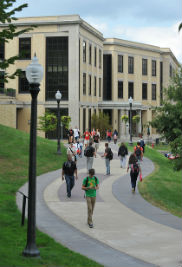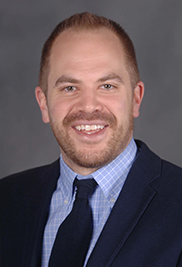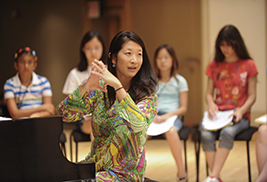eInside Briefs
News Briefs
- Kent State Ranks Again as One of the Best National Universities by U.S. News & World Report
- Kent State’s Institute for Applied Linguistics Receives NEH Grant to Host Translation Institute
- Kent State Professor Honored by ARCHITECT Magazine in Prestigious Competition
- Award-Winning Author Named Writer-in-Residence for Kent State’s School of Library and Information Science
- Applications for Piano Studies Being Accepted for Children, Ages 4 - 17
- Call for Kent State Alumni Award Nominations
Kent State Ranks Again as One of the Best National Universities by U.S. News & World Report
Kent State is the only public university in Northeast Ohio to earn a prestigious first-tier ranking

Students walk to and from class along
the Lefton Esplanade on the Kent
Campus.
Once again, Kent State University has earned a coveted spot in the first-tier list in the Best National Universities category with its inclusion in the 2015 edition of Best Colleges by U.S. News & World Report. Kent State ranks 194 on the prestigious list, improving from last year’s ranking of 201.
Kent State is the only public university in Northeast Ohio to make the first tier. This is the fourth time in five years that Kent State has appeared on the first tier of the Best National Universities rankings.
"Among many things, the rankings track retention and graduation rates, which have reached record levels at Kent State,” says Todd Diacon, Kent State’s senior vice president for academic affairs and provost. “We are pleased that this year's ranking confirms both the hard work of our students, faculty and staff, and that Kent State is a first-choice school for Ohio high school graduates."
The rankings are based on several key measures of quality. The scoring breakdown of the measures and their weighting is graduation and retention rates (22.5 percent), assessment of excellence (22.5 percent), faculty resources (20 percent), student selectivity (12.5 percent), financial resources (10 percent), graduation rate performance (7.5 percent) and alumni giving (5 percent).
Going forward, Kent State is reporting the highest retention rate in its 104-year history at 81.7 percent, up from 77.6 percent last year. This represents the percentage of freshmen who continue their studies at the university for their sophomore year.
The 2015 rankings are posted online at www.usnews.com/colleges. They also will appear in the print edition of the “Best Colleges 2015” guidebook that can be purchased online or on newsstands Sept. 23.
For more information about U.S. News & World Report’s Best College 2015 edition, visit www.usnews.com/colleges.
back to top
Kent State’s Institute for Applied Linguistics Receives NEH Grant to Host Translation Institute
The National Endowment for the Humanities (NEH) has awarded the Institute for Applied Linguistics in the College of Arts and Sciences at Kent State University, a $166,000 grant to host a three-week summer institute on literature in translation as a means of enhancing cross-cultural understanding. The summer institute will be attended by 30 college and university teachers from across the U.S.
The project is titled “What is Gained in Translation?” and will provide professional development opportunities for college faculty. Led by two professors in Kent State’s Department of Modern and Classical Languages, Brian Baer, Ph.D., and Françoise Massardier-Kenney, Ph.D., director of the Institute for Applied Linguistics, the institute will run June 7– 27, 2015. It is one of 15 Institutes for university and college teachers funded by the NEH.
The grant, part of $34 million in grants for 177 humanities projects recently announced by the NEH, was one of only three awarded to Ohio institutions. The two others were awarded to the Ohio Historical Society in Columbus.
The institute will focus on features of translated literary texts that distinguish them from texts that are written and read in the same language in order to explore the complexities involved in cross-cultural communication.
“The institute will investigate the deep cultural beliefs and assumptions, related to time, space and agency, that shape the production and reception of the original text, and, through a series of case studies, explore the role played by translators in presenting that culture to a new audience,” says Massardier-Kenney. “Informed by discussions of contemporary translation scholarship, participants will consider translated texts not as mere copies of an original, but as versions that provide points of access to the source culture as it is shaped both by the translator’s voice and the receiving culture’s beliefs and practices.”
The institute’s mission is to provide participants with the resources necessary to engage with the specific questions posed by translated texts. The readings and discussions at the institute will enable participants to use translated texts more knowledgeably in their classrooms and their research.
“As American colleges and universities seek to globalize their curriculums, instructors have come to rely more and more on translated texts,” Baer says. “Many instructors do not know how to address the texts that have been selected and re-presented in another language for an audience often very different from that of the original. The failure to treat the specificity of translated texts in a pedagogically sound way increases the likelihood that these texts will be made to align with the reader’s previously held cultural beliefs and perspectives, and that their ‘difference’ will be lost.”
“The National Endowment for the Humanities is proud to support these exceptional research, educational and public programs in the humanities,” says Carole Watson, acting chairman of the NEH. “The projects made possible by these grants will enrich our knowledge of our history and ourselves, encourage reflection on the traditions and values that have shaped our culture, and help preserve and make accessible our nation’s diverse wealth of humanities materials and resources.”
Kent State's Institute for Applied Linguistics has the largest graduate (M.A. and Ph.D.) translation studies program in the U.S. and is recognized internationally as a leading translation studies research and instructional center with 10 tenured/tenure-track translation studies faculty members. It is home to Translation and Interpreting Studies (TIS), one of only two American journals devoted to the study of translation, and the American Translation Association Scholarly Series. For more information about Kent State’s Institute of Applied Linguistics, visit http://appling.kent.edu.
The NEH, created in 1965 as an independent federal agency, supports research and learning in history, literature, philosophy and other areas of the humanities by funding selected, peer-reviewed proposals from around the nation. For more information about the NEH, visit www.neh.gov.
back to top
Kent State Professor Honored by ARCHITECT Magazine in Prestigious Competition
Brian Peters’ use of 3D printing brings bricks into the digital age

Brian Peters, assistant professor in
Kent State University’s College of
Architecture and Environmental Design,
was selected by ARCHITECT magazine
for one of its prestigious 2014 R+D Awards.
Brian Peters, assistant professor in Kent State University’s College of Architecture and Environmental Design, was selected by ARCHITECT magazine for one of its prestigious 2014 R+D Awards. ARCHITECT magazine is the leading magazine for architecture in the U.S., and the official magazine of the American Institute of Architects (AIA).
Peters’ project, Building Bytes, was one of only six award winners selected from more than 100 entries.
Building Bytes combines a traditional building material (ceramics) with a new fabrication technique (3D printing) to rethink an ancient building component to demonstrate how 3D printers will become portable brick factories for large-scale construction. Building Bytes is an ongoing research project looking into digitally fabricated building blocks.
Peters’ technique does not rely on molds, but rather each brick is printed individually, allowing users to fabricate complex and unique brick shapes. Building Bytes offers designers and architects far more exciting and useful designs than a standard extruded brick. Printed bricks can have complex exterior surfaces, permitting interlocking or curvature of the final structure, while their internal structure can be engineered to significantly lower their weight or increase their strength at stress points for a particular build.
All the bricks were printed using a standard desktop 3D printer with a custom print head made to extrude a liquid ceramic mixture. The bricks where printed in thin layers that slowly added up to produce the final shape. Each brick required approximately 15-20 minutes to print, and after printing, the bricks were air dried for one day and then fired in a kiln.
“It is an honor to have my work selected by leading practitioners in the field of architecture and be recognized alongside leading research institutions and practices,” Peters says. “It is also exciting to help promote research into digital fabrication at Kent State’s College of Architecture and Environmental Design and my Robotic Fabrication Laboratory.”
“Brian came to Kent State ready to make things and conduct research,” says William Willoughby, associate dean of Kent State’s College of Architecture and Environmental Design. “His research is right at the intersection between sustainable building materials and innovative digital fabrication techniques.”
This year’s R+D Awards show how craftsmanship is evolving and thriving in the computer age, according to the magazine. The winners stood out for their potential to inject architecture with intelligence, upgrade longstanding manufacturing and construction methods, and overhaul entire streetscapes and cities.
The projects were evaluated by jurors Gerardo Salinas, Mimi Love and Bill Kreysler.
Salinas praised Peters’ reinvention of the brick as a variable module with the potential to “do mass customization in a very clever way.” Love pointed out that the result is “not an extruded piece of clay anymore, but something that can vary in all three dimensions.”
A complete list of the winners is available at www.architectmagazine.com/awards/randd-awards.
For more information about Kent State’s College of Architecture and Environmental Design, visit
www.kent.edu/caed.
back to top
Award-Winning Author Named Writer-in-Residence for Kent State’s School of Library and Information Science

Award-winning young adult and
children’s author Angela Johnson has
been named the first writer-in-residence
for Kent State University’s School of
Library and Information Science.
Award-winning young adult and children’s author Angela Johnson has been named the first writer-in-residence for Kent State University’s School of Library and Information Science.
Johnson is the author of more than 40 children’s books about African-American families, friendships and coming-of-age stories based on her own childhood experiences and relevant themes for children and young adults. She has received several prestigious awards for both her picture books and young adult novels. Most notably, she is a three-time winner of the Coretta Scott King Award, and she received the American Library Association’s Michael L. Printz Award in 2004 for The First Part Last, which was hailed as the year’s “best book written for teens, based entirely on its literary merit.”
Johnson’s newest picture book, All Different Now: Juneteenth, the First Day of Freedom, tells the story of the first Juneteenth, the day of freedom for the last of the slaves in the south. It was released in May 2014.
In addition to the honors and accolades for her publications, Johnson received a 2003 MacArthur Genius Grant, given to “talented individuals who have shown extraordinary originality and dedication in their creative pursuits and a marked capacity for self-direction.”
Johnson was born in Tuskegee, Alabama, grew up in Windham, Ohio, and attended Kent State. She now resides in Kent.
In her role as writer-in-residence, Johnson will have an office in the school’s Reinberger Children’s Library Center, home of the Marantz Picturebook Collection for the Study of Picturebook Art, which features more than 28,000 children’s picturebooks. Johnson will use the collection for research and inspiration for her own writing. In addition, Johnson will volunteer her expertise through participation in workshops, course lectures, conferences and symposia, and other school events and activities as appropriate.
“It’s quite an honor for the school to have Angela Johnson as our first writer-in-residence,” says Jeff Fruit, interim director of the School of Library and Information Science. “Our youth librarianship program is ranked 10th in the country by U.S. News and World Report, and I’m sure that this kind of connection will enhance our reputation many times over. It’s a wonderful opportunity for our students, our faculty and other members of the university community to work alongside a writer of such renown.”
The School of Library and Information Science at Kent State offers a Master of Library and Information Science (M.L.I.S.) and Master of Science in Information Architecture and Knowledge Management (IAKM). In addition, the school participates in an interdisciplinary Ph.D. in the College of Communication and Information. With more than 700 students enrolled, the School of Library and Information Science has the largest graduate program at Kent State. Its M.L.I.S. is the only American Library Association-accredited master’s program in Ohio and is recognized by U.S. News and World Report among the nation’s top 20 library and information science programs, with a youth services program that is ranked 10th. For more information, visit www.kent.edu/slis.
back to top
Applications for Piano Studies Being Accepted for Children, Ages 4 - 17

Donna Lee, Ph.D., Kent State associate professor of
music, instructs students taking piano lessons.
The Teaching Institute Program of Kent State University is now accepting applications for children between the ages of 4-17 interested in piano studies. This program provides quality piano lessons to the Kent community and surrounding areas. Lessons are taught by qualified undergraduate and graduate piano majors, and monitored by piano program faculty. Besides weekly lessons, students participate in a master class taught by co-directors Donna Lee, Ph.D., and Jerry Wong, Ph.D. A recital is presented at the end of each semester as well.
For more information or to schedule an audition, contact Lee at dlee3@kent.edu.
back to top
Call for Kent State Alumni Award Nominations
The Kent State University Alumni Association invites faculty and staff to nominate deserving alumni for the Kent State University Alumni Awards. Sponsored by the alumni association, the Alumni Awards recognize graduates in the area of leadership, service, character and professional development.
One student award – the Golden Flash award – also will be given to a student who promotes Kent State spirit, pride and tradition.
Nominations will be accepted through Dec. 31, and award recipients will be honored at the Alumni Awards Ceremony in fall 2015. To nominate an individual, visit www.ksualumni.org/alumniawards.
back to top